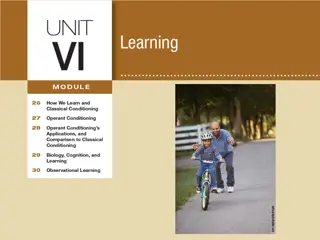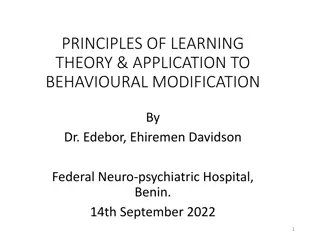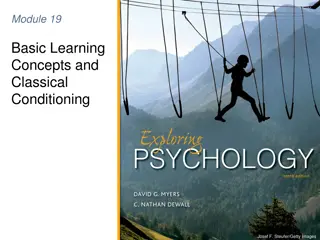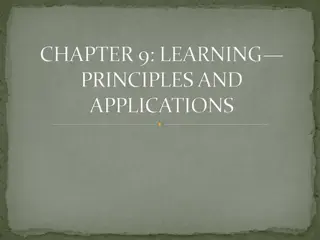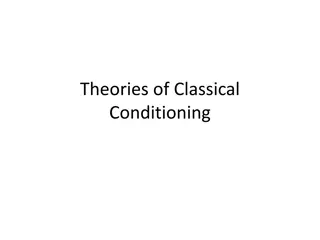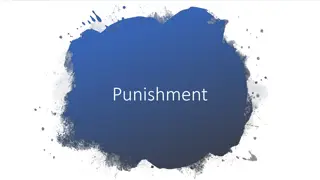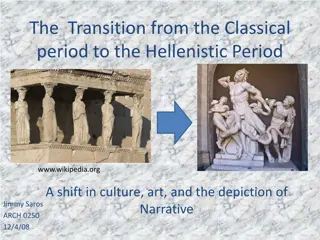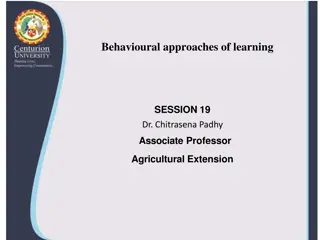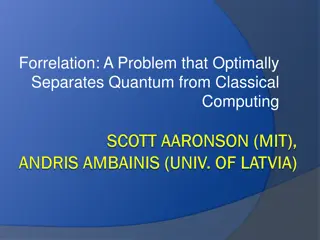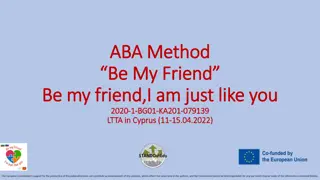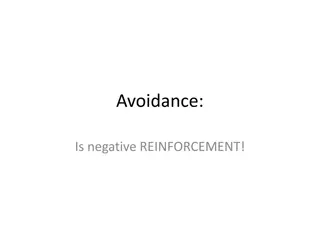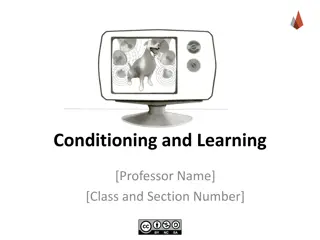Examples of Classical and Operant Conditioning
Robert receiving a ticket for driving under the influence illustrates operant conditioning with negative punishments, while Chris being afraid of dogs after being bitten showcases classical conditioning with stimulus generalization. Jacob's joy from smelling his date's cologne demonstrates classical conditioning, and Martin's fear of airplanes despite not flying for years reveals classical conditioning as well.
Download Presentation

Please find below an Image/Link to download the presentation.
The content on the website is provided AS IS for your information and personal use only. It may not be sold, licensed, or shared on other websites without obtaining consent from the author. Download presentation by click this link. If you encounter any issues during the download, it is possible that the publisher has removed the file from their server.
E N D
Presentation Transcript
(1) Robert gets a ticket for driving under the influence that results in a $500 fine and suspension of his driving license. Is this classical or operant conditioning? What's the behavior involved? Will it increase or decrease? What kind of consequence is involved? Explanation: This is operant conditioning because the behavior is voluntary and it was followed with a consequence. The behavior is driving under the influence and it should decrease in this example (a strict behaviorist would obviously want some proof of this first). The consequences are both negative punishments. They would be punishments because the behavior will decrease and they are negative because they both involve something taken away (money and driving privileges).
Chris is bitten by the neighbor's German Shepherd. Now whenever she sees a dog in the neighborhood, she becomes afraid and runs away. She still enjoys petting her own family's cocker spaniel. Is this classical or operant conditioning? What is the conditioned stimulus? Unconditioned stimulus? Conditioned and unconditioned response? Is this an example of stimulus generalization? Stimulus discrimination? Explanation: This example is a bit more complicated because it involves mostly classical conditioning, but operant conditioning is present too. Her fear response is classically conditioned, because it is an automatic response. Her behavior of running away is operant conditioning because it is a voluntary behavior. The CS in this example is the sight of a dog in the neighborhood. The US was the dog bite from the German Shepherd. The UR and the CR are both fear. Stimulus generalization occurs when her CR generalizes to other dogs in the neighborhood. Her behavior shows discrimination in that the CR does not occur with her own dog.
Jacob's date was wearing a very alluring cologne on their recent date. The date itself was quite passionate. The following day when Jacob gets into his car he smells the lingering scent of his date's cologne and becomes transfixed with joy. Is this classical or operant conditioning? What is the unconditioned stimulus? Conditioned stimulus? Unconditioned and conditioned response? Is this an example of stimulus generalization or discrimination? Can Jacob forget about his date and just go purchase a bottle of the cologne? Will his reaction subside? Explanation: This is an example of classical conditioning, because the response of becoming transfixed with joy is automatic. The US would be the passionate date, which led to the UR of a joyful reaction. The CS was the scent of the cologne and the CR would be the joyful reaction. Stimulus generalization and discrimination are not involved here, but could be if Jacob responds in a similar way to other colognes and then develops a specific response to just the cologne worn by his date.
Martin has a panic attack during a plane ride. Now the mere thought of an airplane makes him very nervous. Twenty years pass and Martin is still afraid of airplanes even though he never took another flight. Is this classical or operant conditioning? What are the US, CS, UR, and CR? Why hasn't this response extinguished? Explanation: This example is primarily classical conditioning, because his fear response is automatic. (However, the choice to avoid planes would be a voluntary, operant conditioning, behavior.) The US would be the panic attack and the UR would be the fear it automatically triggered. The CS would be the airplane and the CR would be fear (the response has apparently generalized to all planes). The response hasn't extinguished in 20 years because Martin never went through extinction. He would need to be exposed to the CS (airplanes) without the US (panic attacks) over many trials for his CR (fear) to extinguish.
You throw a wild party at which you consume too much alcohol (vodka and orange juice). You become very sick and spend a few hours vomiting. The next morning while cleaning up the mess, you get a whiff of the vodka and orange juice that were still sitting out in the kitchen. You immediately become nauseated and run to the bathroom to vomit some. Classical or operant? What are the assorted stimuli and responses involved? Explanation: The main focus in this example is on classically conditioned behaviors, because nausea is an automatic response. (However, I should point out that throwing parties, drinking alcohol, and learning from your mistakes are voluntary and would be examples of operant conditioning.) The US is nausea (caused by alcohol poisoning) and the UR is the retching and vomit reflex. The CS is the smell of vodka/orange juice (both or either) and the CR is the retching and vomit reflex. (You would probably also have a strong CS-CR with the taste and possibly the sight of vodka and orange juice.)
Shelly is in the grocery store with her dad. As they near the checkout lane, Shelly starts whining for a candy bar but her dad says no. Shelly begins to cry and cries louder when her dad continues to refuse. At the checkout lane, in front of the cashier, Shelly throws herself onto the floor and begins screaming. Her dad responds by grabbing a candy bar and giving it to her. She quickly quiets down and eats her candy bar. This exchange gets repeated on subsequent trips to the grocery store. Classical or operant? What is Shelly's behavior in this example? What kind of consequence follows her behavior? What is dad's behavior in this example? What kind of consequence follows his behavior? How should dad handle this situation differently?
Your bright cat has learned that your presence in the kitchen is associated with food. Your cat has also learned that he can encourage your presence in the kitchen on Saturday mornings by standing on your chest and meowing (when you are obviously trying to sleep). You decide to get up and feed the cat to shut it up, but the problem only gets worse on subsequent weekends. Classical or operant? You know the drill. If it's operant, what kind of consequence is involved? If it's classical, what are the assorted stimuli and responses? Could it be both operant and classical? Explanation: Most of what I have described here is operant conditioning because it involves voluntary behaviors (cat standing on your chest and meowing, you getting up and feeding the cat). However, there is also an undescribed element of classical conditioning in which the cat has learned to associate you with the delivery of food and now automatically responds to your presence in the kitchen with a similar emotional response (joy?). The cat's behavior of bothering you is positively reinforced because the cat receives something (food) and the behavior increases. Your behavior is negatively reinforced because feeding the cat puts an end to its annoying behavior and we would expect you to repeat this behavior in the future. This is essentially the same as the preceding example and I would recommend a different course unless you enjoy the cat's annoying behavior. It will probably backfire if you try to punish the cat for meowing, so the best thing to do is to ignore the cat (extinction) and feed it when it is being quiet.
Explanation: This example is operant conditioning, because most of the behaviors in question are voluntary (whining, temper tantrums, giving candy bars, being quiet). Shelly's behavior is whining (then crying and throwing a temper tantrum), which is followed eventually by a candy bar. This is an example of positive reinforcement because something is given to her (the candy bar), which will increase her behavior (crying, whining) in the future. Dad's behavior is giving the candy bar, which is followed with peace and quiet. This is an example of negative reinforcement because something is taken away (the crying and whining) and dad's behavior (giving candy bars) will increase in the future. The obvious problem in this situation is that undesirable behaviors are being reinforced, which will make matters worse in the future. There are many ways the dad could handle the situation better, but the bottom line is to avoid providing reinforcement for a behavior that is undesirable. He could ignore the behavior (extinction) or he could punish the behavior (for example, using a negative punishment like taking away the privilege of going to the grocery store in the future).





